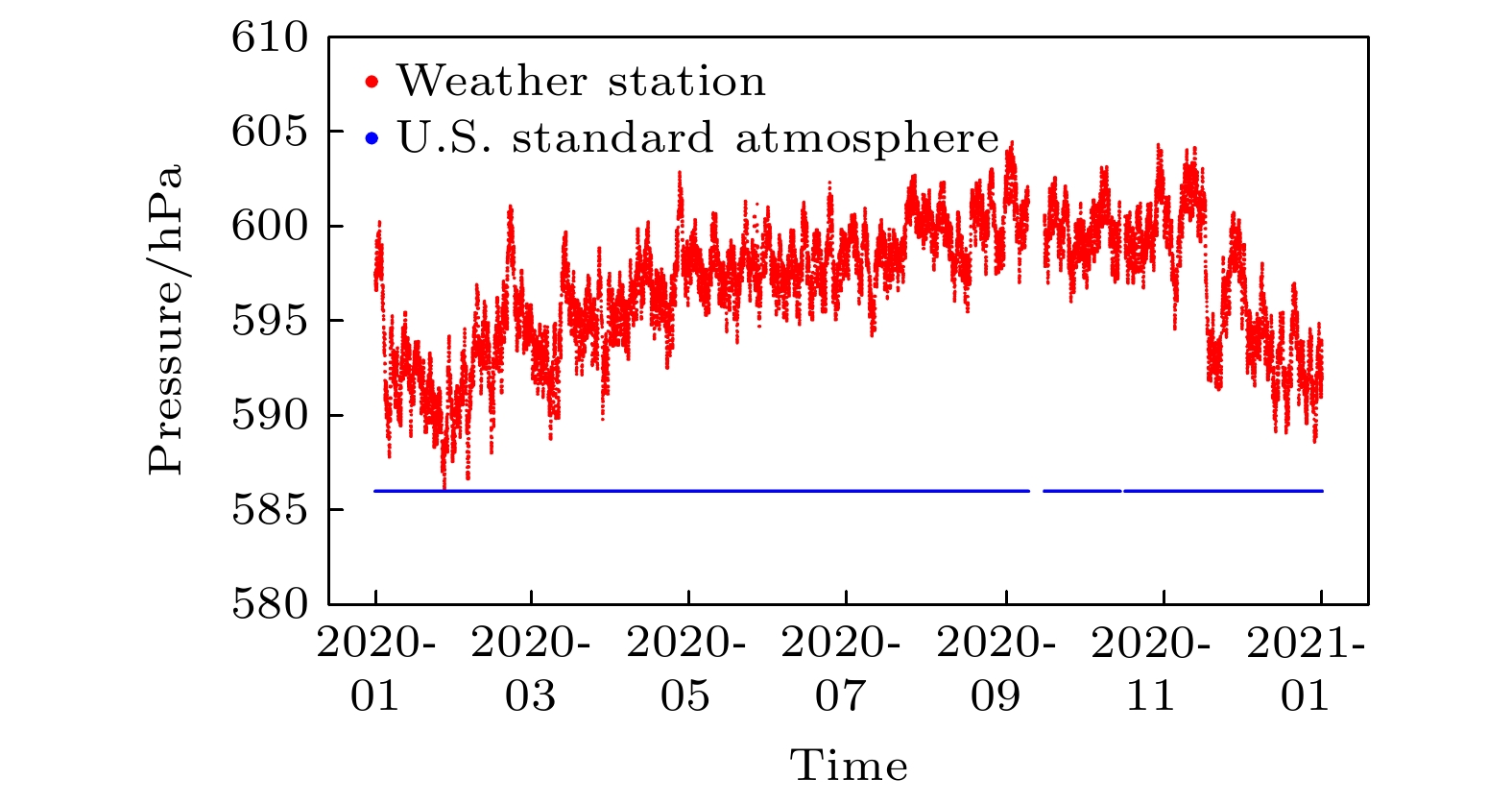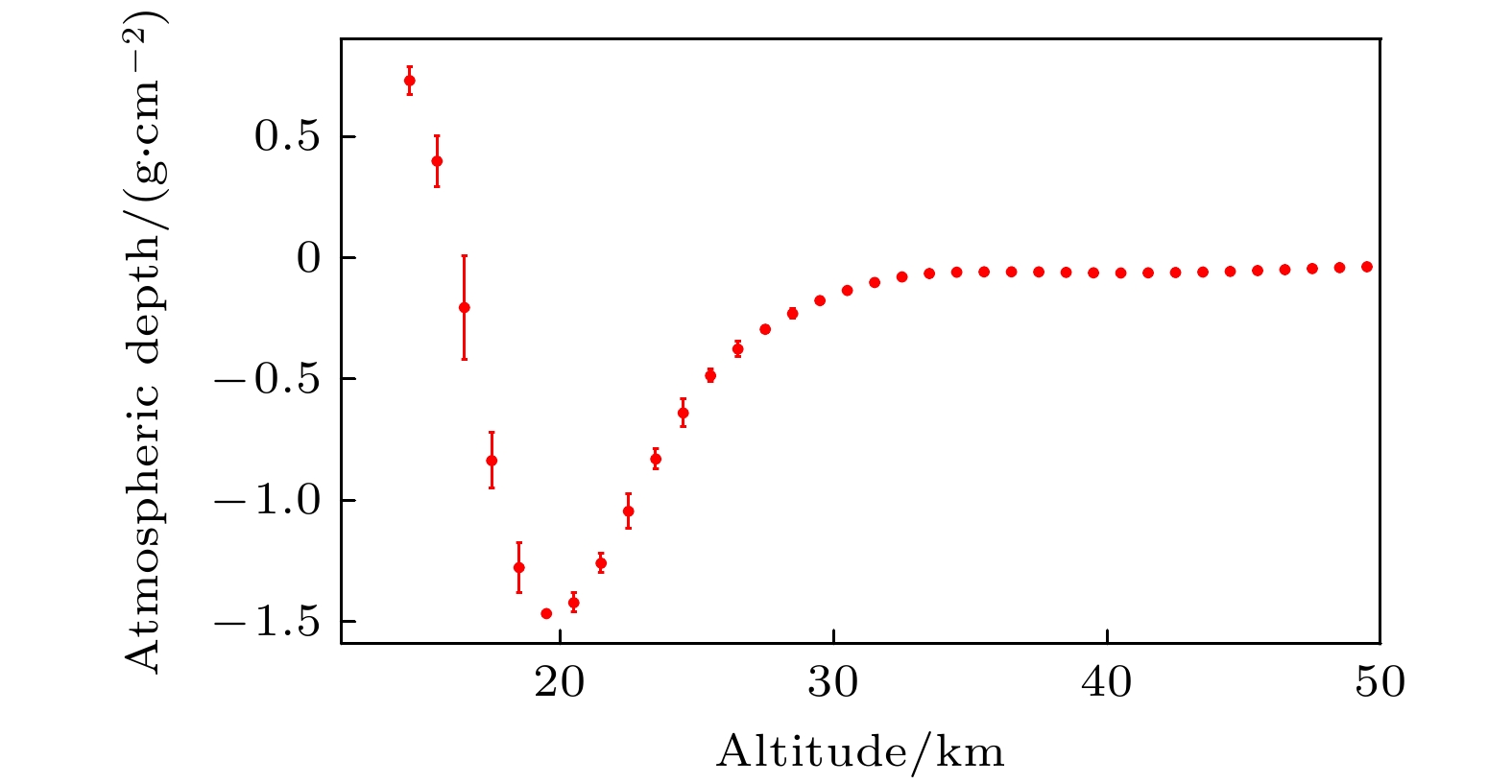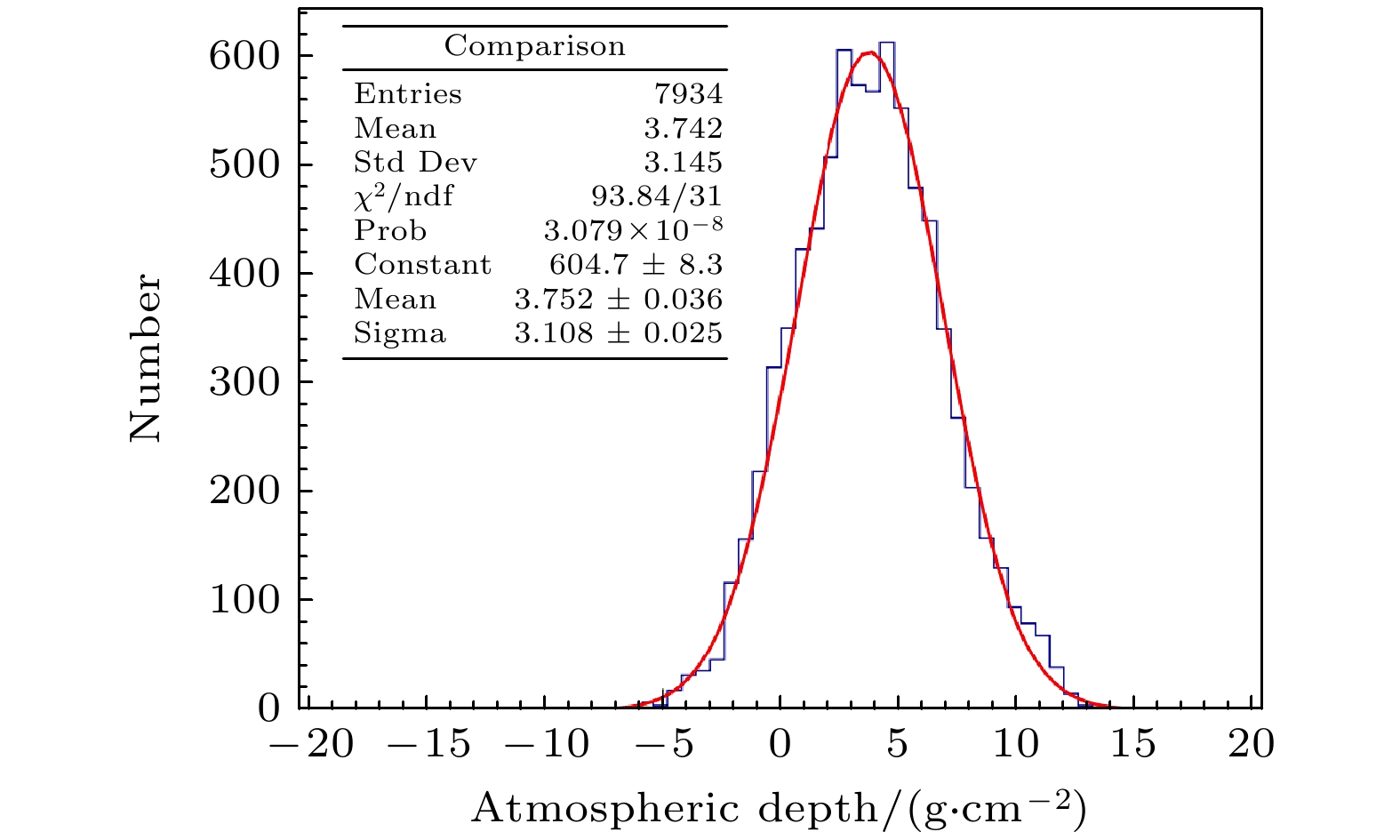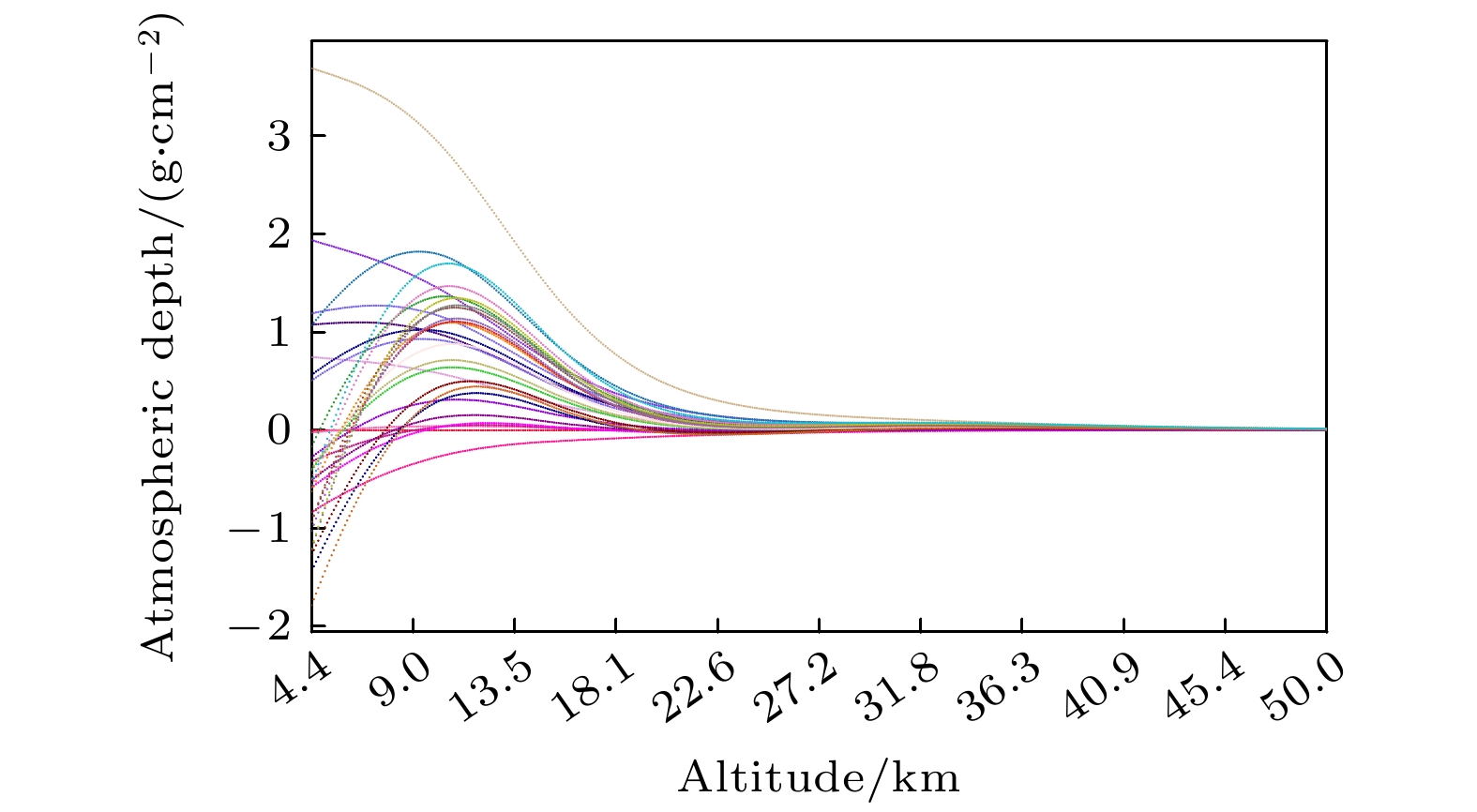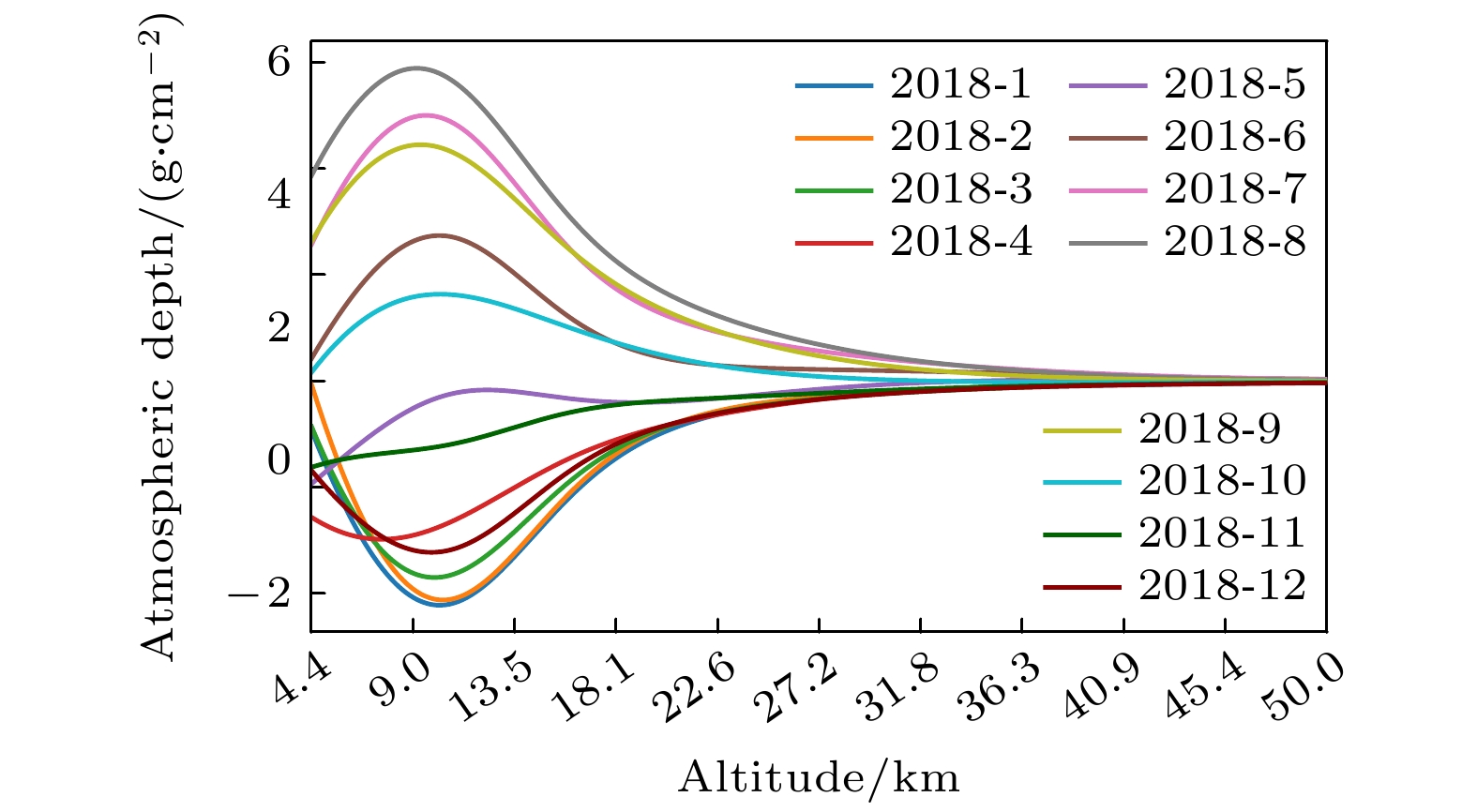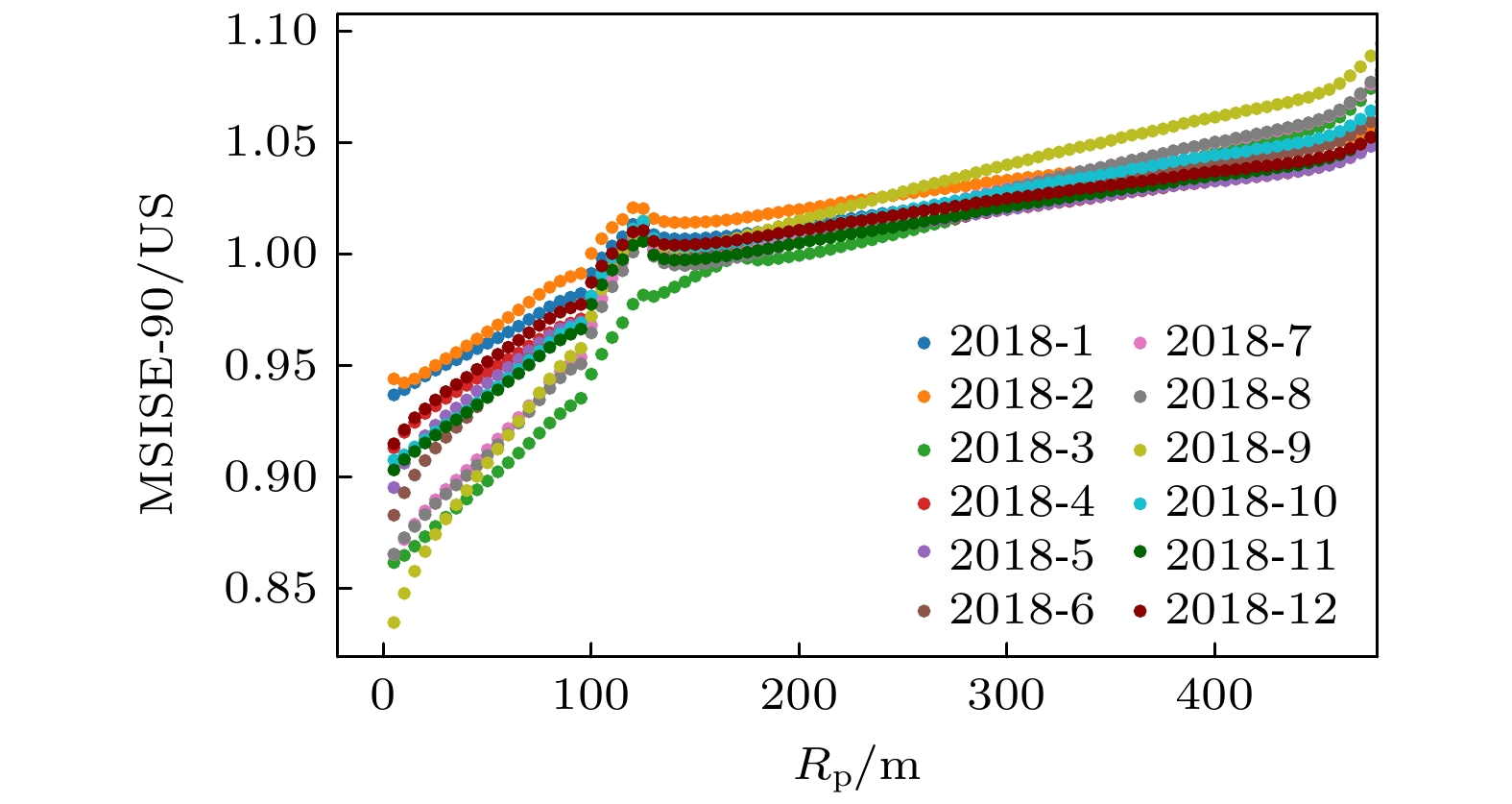-
高海拔宇宙线观测站(LHAASO)位于四川省稻城县海子山, 它的广角切伦科夫望远镜阵(WFCTA)主要是通过观测广延大气簇射过程中产生的切伦科夫光信号对宇宙线进行研究. WFCTA 的标定、模拟和重建都和大气深度有关, 目前使用的大气深度模型是美国标准大气深度廓线模型. 本研究中将美国标准大气深度廓线模型与卫星 TIMED搭载的红外辐射计SABER记录到的LHAASO处14—50 km处的大气深度廓线进行比较, 同时也与LHAASO处地面气象站记录的大气深度进行比较, 美国标准大气模型的大气深度均偏小. MSISE-90大气模型描述了地球大气中从地面到热层的中性温度和密度, 进一步研究发现MSISE-90大气模型与TIMED/SABER和LHAASO处地面标准气象站记录的大气深度的一致性较好. 根据MSISE-90大气模型计算得到LHAASO处的大气深度均值廓线在1月最低, 其次是2月、3月、4月、11月和12月, 这也是 WFCTA运行的最佳观测月份. 4月份的大气边界层最高, 其大气深度存在约2%的日变化. 利用美国标准大气模型的函数形式, 拟合每月的4.4—100 km处的大气深度廓线, 得到了LHAASO处的每月的大气深度廓线模型, 并比较了30°天顶角入射的100 TeV 的宇宙线质子在MSISE-90大气模型和美国标准大气模型中产生的切伦科夫光的横分布的差异, 二者最大差异约可以达到20%.
-
关键词:
- MSISE-90大气模型 /
- 大气深度廓线 /
- 高海拔宇宙线观测站 /
- 切伦科夫光
High altitude cosmic ray observatory (LHAASO) is located at Haizi Mountain in Daocheng county, Sichuan province, China. Its wide field of view Cherenkov telescope array (WFCTA) is primarily used to study cosmic rays through observing the Cherenkov light signals produced during extensive air showers. Calibration, simulation, and reconstruction of WFCTA are all related to atmospheric depth. The atmospheric depth model currently used is the US standard atmosphere depth profile model. In this study, the US standard atmosphere depth profile model is compared with the atmospheric depth profile recorded by the infrared radiometer SABER carried by the satellite TIMED at LHAASO from 14 km to 50 km, and also with the atmospheric depth recorded by the ground meteorological station at LHAASO. The atmospheric depth obtained from the US standard atmosphere model is consistently smaller. The MSISE-90 atmospheric model describes the neutral temperature and density from the Earth's surface to the thermosphere. Further research shows good consistency between the MSISE-90 atmospheric model and the atmospheric depth recorded by TIMED/SABER and the ground standard meteorological station at LHAASO. According to the MSISE-90 atmospheric model, the average atmospheric depth profile at LHAASO is lowest in January, followed sequentially by February, March, April, November, and December, which are also the optimal observation months for WFCTA operation. The atmospheric boundary layer is highest in April, with the diurnal variation of atmospheric depth being about 2%. Using the functional form of the US standard atmosphere odel, the monthly atmospheric depth profile of the LHAASO site is obtained by fitting an atmospheric depth profile of 4.4 to 100 km per month. And the comparison between the lateral distribution of the Cherenkov photons produced by 100 TeV cosmic-ray protons incident at a zenith angle of 30° in the MSISE-90 atmospheric model and that in the US standard atmosphere model shows that their maximum difference reaches about 20%.-
Keywords:
- the MSISE-90 atmospheric model /
- atmospheric depth profiles /
- large high altitude air shower observatory /
- Cherenkov photon
[1] He H H 2018 Radiation Detection Technology and Methods 2 1
 Google Scholar
Google Scholar
[2] 曹臻, 陈明君, 陈松战, 胡红波, 刘成, 刘烨, 马玲玲, 马欣华, 盛祥东, 吴含荣, 肖刚, 姚志国, 尹丽巧, 查敏, 张寿山 2019 天文学报 60 3
 Google Scholar
Google Scholar
Cao Z, Chen M J, Chen S Z, Hu H B, Liu C, Liu Y, Ma L L, Ma X H, Sheng X D, Wu H R, Xiao G, Yao Z G, Yin L Q, Zha M, Zhang S S 2019 Acta Astronomica Sinica 60 3
 Google Scholar
Google Scholar
[3] LHAASO Collaboration 2021 Science 373 425
 Google Scholar
Google Scholar
[4] LHAASO Collaboration 2021 Nature 594 33
 Google Scholar
Google Scholar
[5] LHAASO Collaboration 2022 Nuclear Instruments and Methods in Physics Research A 1021 165824
 Google Scholar
Google Scholar
[6] LHAASO Collaboration 2021 Eur. Phys. J. C 81 657
 Google Scholar
Google Scholar
[7] Xie N, Liu H, Hu Y, Long W J, Jia H Y, Zhu F R, Chen Q H 2019 36th International Cosmic Ray Conference (ICRC2019), Madison, USA, July 24–August 1, 2019 498
[8] Sun Q N 2021 37th International Cosmic Ray Conference (ICRC2021), Berlin, Germany, July 12–23, 2021 272
[9] Chen L, Li X, Ge L S, Liu H, Sun Q N, Wang Y, Xia J J, Zhu F R, Zhang Y 2021 37th International Cosmic Ray Conference (ICRC2021), Berlin, Germany, July 12–23, 2021 269
[10] 李新, 陈龙, 耿利斯, 刘虎, 孙秦宁, 王阳, 夏君集, 祝凤荣, 张勇 2022 天文研究与技术 19 244
 Google Scholar
Google Scholar
Li X, Chen L, Geng L S, Liu H, Sun Q N, Wang Y, Xia J J, Zhu F R, Zhang Y 2022 Astronomical Research&Technology 19 244
 Google Scholar
Google Scholar
[11] Sun Q N, Jin M, Xia J J, Liu J, Min Z, Zhu F R, Chen L, Wang Y, Liu Y, Zhang Y 2023 38th International Cosmic Ray Conference (ICRC2023), Nagoya, Japan, July 26–August 3, 2023 498
[12] Sun Q N, Wang Y, Chen L, Zhang Y, Zhu F R 2023 38th International Cosmic Ray Conference (ICRC2023), Nagoya, Japan, July 26–August 3, 2023 496
[13] Sun Q N, Min Z, Liu H, Zhu F R, Zhang S S, Long C, Wang Y 2023 38th International Cosmic Ray Conference (ICRC2023), Nagoya, Japan, July 26–August 3, 2023 494
[14] 柳靖, 唐晓凡, 夏君集, 祝凤荣 2024 高原山地气象研究 44 1674
Liu J, Tang X F, Xia J J, Zhu F R 2024 Plateau and Mountain Meteorology Research 44 1674
[15] Heck D, Knapp J, Capdevielle J N, Schatz G, Thouw T 1998 Corsika: A monte carlo code to simulate extensive air showers (Wissenschaftliche Berichte, FZKA-6019) pp1–54
[16] National Geophysical Data Center 1976 Planetary and Space Science 40 553
 Google Scholar
Google Scholar
[17] Wilczyńska B, Góra D, Homola P, Pe¸kala J, Risse M, Wilczyński H 2006 Astropart. Phys. 25 106
 Google Scholar
Google Scholar
[18] Keilhauer B, Will M, Pierre Auger Collaboration 2012 Eur. Phys. J. Plus 127 96
 Google Scholar
Google Scholar
[19] Pierre Auger Collaboration 2012 Astropart. Phys. 35 591
 Google Scholar
Google Scholar
[20] HiRes Collaboration 2001 Proceedings of the 27th International Cosmic Ray Conference, Hamburg, Germany, August 7–15, 2001 653
[21] HESS Collaboration 2003 Proceedings of the 28th International Cosmic Ray Conference, Tsukuba, Japan, July 31–August 7, 2003 2879
[22] The Veritas Collaboration 2008 VERITAS Collaboration Contributions to the 31st International Cosmic Ray Conference, Lodz, Poland, July, 2008
[23] The Telescope Array Collaboration 2001 27th International Cosmic Ray Conference (ICRC2001), Hamburg, Germany, August 7–15, 2001 663
[24] Schmuckermaier F, Gaug M, Fruck C, Moralejo A, Hahn A, Dominis Prester D, Dorner D, Font L, Mićanović S, Mirzoyan R, Paneque D, Pavletić L, Sitarek J, Will M 2023 Astron. Astrophys. 673 25
 Google Scholar
Google Scholar
[25] Hedin A, Res J G 1991 J. Geophys. Res. 96 1159
 Google Scholar
Google Scholar
[26] NASA CCMC MSIS Vitmo Model [2024-03-27]
[27] 程旋, 肖存英, 胡雄, 杨钧烽 2018 中国科学: 物理学 力学 天文学 48 79
Cheng X, Xiao C Y, Hu X, Yang J F 2018 SCIENTIA SINICA Physica, Mechanica & Astronomica 48 79
[28] 宫晓艳, 胡雄, 吴小成, 肖存英 2013 地球物理学报 56 2152
Gong X Y, Hu X, Wu X C, Xiao C Y 2013 Chin. J. Geophy. 56 2152
[29] Dai Y R, Pan W L, Qiao S, Hu X, Yan Z A, Ban C 2020 Chinese Journal of Space Science 40 207
 Google Scholar
Google Scholar
[30] Hedin A E, Salah J E, Evans J V, Reber C A, Newton G P, Spencer N W, Kayser D C, Alcayde D, Bauer P, Cogger L, McClure J P 1977 J. Geophys. Res. 82 2139
 Google Scholar
Google Scholar
[31] Hedin A E 1987 J. Geophys. Res. 92 4649
 Google Scholar
Google Scholar
[32] Picone J M, Hedin A E, Drob D P, Aikin A C 2002 J. Geophys. Res. 107 1468
 Google Scholar
Google Scholar
[33] Labitzke K, Barnett J J, Edwards B 1985 Handbook MAP 16
[34] Fleming E L, Chandra S, Barnett J, Corney M 1990 Adv. Space Res. 10 11
[35] 张丰, 刘虎, 祝凤荣 2022 物理学报 71 472
Zhang F, Liu H, Zhu F R 2022 Acta Phys. Sin. 71 472
[36] Liu J R, Wu H X, Liu Q, Ji Y J, Xu R, Zhang F, Liu H 2024 Universe 10 100
 Google Scholar
Google Scholar
-
图 3 SABER和MSISE-90模型在29天内得出的平均大气深度廓线的比较. y轴表示SABER的大气深度廓线减去与MSISE-90模型对应的大气深度的差值
Fig. 3. Comparison of the mean atmospheric depth profile derived from SABER and MSISE-90 model in 29 days. The y-axis represents for the difference of the mean atmospheric depth profile from SABER minus that from MSISE-90 model
图 4 MSISE-90 模型的大气深度减去气象站数据的大气深度的分布, MSISE-90 的大气深度与地面标准气象站的记录非常一致, 平均值为$ (3.752\pm0.036 )\, \text{ g/cm}^2 $, 可能是两个大气深度之间的系统性差异
Fig. 4. Distribution of atmospheric depth with MSISE-90 model minus weather station data. The atmospheric depth of MSISE-90 is very consistent with records from standard weather stations on the ground, with an average of (3.752 ± 0.036) g·cm–2. It could be a systematic difference between the two atmospheric depths.
图 7 每月大气深度模型与美国标准大气模型产生的切伦科夫光的横向分布的比值随Rp的变化. y轴表示切伦科夫光密度比值, x轴表示到簇射轴的距离
Fig. 7. Variation of Cherenkov light ratio with Rp in monthly atmospheric depth models versus US standard atmosphere. The y-axis represents the ratio of Cherenkov light density, and the x-axis represents the distance to the shower axis.
表 1 大气深度模型参数
Table 1. Atmospheric depth model parameters
Month Layer i Altitude h/km ai/(g·cm–2) bi/(g·cm–2) ci/(g·cm–2) Jan 1 4.4—10 –88.67664 1153.38932 885318.24144 2 10—40 0.1503 1368.33236 635083.57589 3 40—70 0.00097 594.27741 759999.94129 4 70—100 –0.00086 1907.62483 667666.97913 Feb 1 4.4—10 –87.39177 1154.47929 881758.5079 2 10—40 0.15609 1367.33681 635285.9599 3 40—70 0.00027 576.34076 764858.0621 4 70—100 –0.00085 2045.36876 663026.919 Mar 1 4.4—10 –87.84831 1151.6271 885628.7299 2 10—40 0.11315 1369.10268 635555.228 3 40—70 –0.00049 553.3669 771529.8036 4 70—100 –0.00091 2209.83224 658731.9146 Apr 1 4.4—10 –90.25622 1145.51995 897003.8093 2 10—40 0.06234 1373.1308 635903.6963 3 40—70 –0.00116 539.40289 776888.0464 4 70—100 –0.00097 2423.60087 654760.7167 May 1 4.4—10 –94.01004 1143.16428 911761.1959 2 10—40 0.03596 1381.07511 636947.2602 3 40—70 –0.00132 549.94468 776854.1294 4 70—100 –0.00106 2661.49827 651353.7108 Jun 1 4.4—10 –97.91433 1146.13178 925652.5235 2 10—40 0.01816 1390.15178 639198.5601 3 40—70 –0.00087 583.28466 771416.4869 4 70—100 –0.00114 2874.15677 648179.0992 Jul 1 4.4—10 –100.06562 1148.64061 933675.7634 2 10—40 –0.02423 1392.20555 641946.5067 3 40—70 –0.00005 618.18009 764300.351 4 70—100 –0.00111 2927.94379 646356.8679 Aug 1 4.4—10 –100.35386 1151.17543 934589.3083 2 10—40 –0.09651 1391.26844 643717.7458 3 40—70 0.00089 636.09755 759237.935 4 70—100 –0.00106 2753.18923 647878.0245 Sep 1 4.4—10 –98.98887 1149.90531 929337.2904 2 10—40 –0.15062 1386.23148 643237.0362 3 40—70 0.0016 629.96089 757639.8883 4 70—100 –0.00097 2427.85445 653170.7765 Oct 1 4.4—10 –96.77554 1147.98637 919739.3653 2 10—40 –0.13485 1381.02577 640744.2671 3 40—70 0.0019 614.52746 757915.0523 4 70—100 –0.00091 2107.53654 660753.9717 Nov 1 4.4—10 –94.08387 1147.66351 907591.9124 2 10—40 –0.04465 1376.11079 637729.8644 3 40—70 –0.00183 604.50776 758089.8866 4 70—100 –0.00088 1903.76056 667277.3079 Dec 1 4.4—10 –91.25224 1150.55845 895114.7529 2 10—40 0.07201 1372.32941 635695.0018 3 40—70 0.0015 601.61656 758134.5887 4 70—100 –0.00089 1844.46114 669845.4268 -
[1] He H H 2018 Radiation Detection Technology and Methods 2 1
 Google Scholar
Google Scholar
[2] 曹臻, 陈明君, 陈松战, 胡红波, 刘成, 刘烨, 马玲玲, 马欣华, 盛祥东, 吴含荣, 肖刚, 姚志国, 尹丽巧, 查敏, 张寿山 2019 天文学报 60 3
 Google Scholar
Google Scholar
Cao Z, Chen M J, Chen S Z, Hu H B, Liu C, Liu Y, Ma L L, Ma X H, Sheng X D, Wu H R, Xiao G, Yao Z G, Yin L Q, Zha M, Zhang S S 2019 Acta Astronomica Sinica 60 3
 Google Scholar
Google Scholar
[3] LHAASO Collaboration 2021 Science 373 425
 Google Scholar
Google Scholar
[4] LHAASO Collaboration 2021 Nature 594 33
 Google Scholar
Google Scholar
[5] LHAASO Collaboration 2022 Nuclear Instruments and Methods in Physics Research A 1021 165824
 Google Scholar
Google Scholar
[6] LHAASO Collaboration 2021 Eur. Phys. J. C 81 657
 Google Scholar
Google Scholar
[7] Xie N, Liu H, Hu Y, Long W J, Jia H Y, Zhu F R, Chen Q H 2019 36th International Cosmic Ray Conference (ICRC2019), Madison, USA, July 24–August 1, 2019 498
[8] Sun Q N 2021 37th International Cosmic Ray Conference (ICRC2021), Berlin, Germany, July 12–23, 2021 272
[9] Chen L, Li X, Ge L S, Liu H, Sun Q N, Wang Y, Xia J J, Zhu F R, Zhang Y 2021 37th International Cosmic Ray Conference (ICRC2021), Berlin, Germany, July 12–23, 2021 269
[10] 李新, 陈龙, 耿利斯, 刘虎, 孙秦宁, 王阳, 夏君集, 祝凤荣, 张勇 2022 天文研究与技术 19 244
 Google Scholar
Google Scholar
Li X, Chen L, Geng L S, Liu H, Sun Q N, Wang Y, Xia J J, Zhu F R, Zhang Y 2022 Astronomical Research&Technology 19 244
 Google Scholar
Google Scholar
[11] Sun Q N, Jin M, Xia J J, Liu J, Min Z, Zhu F R, Chen L, Wang Y, Liu Y, Zhang Y 2023 38th International Cosmic Ray Conference (ICRC2023), Nagoya, Japan, July 26–August 3, 2023 498
[12] Sun Q N, Wang Y, Chen L, Zhang Y, Zhu F R 2023 38th International Cosmic Ray Conference (ICRC2023), Nagoya, Japan, July 26–August 3, 2023 496
[13] Sun Q N, Min Z, Liu H, Zhu F R, Zhang S S, Long C, Wang Y 2023 38th International Cosmic Ray Conference (ICRC2023), Nagoya, Japan, July 26–August 3, 2023 494
[14] 柳靖, 唐晓凡, 夏君集, 祝凤荣 2024 高原山地气象研究 44 1674
Liu J, Tang X F, Xia J J, Zhu F R 2024 Plateau and Mountain Meteorology Research 44 1674
[15] Heck D, Knapp J, Capdevielle J N, Schatz G, Thouw T 1998 Corsika: A monte carlo code to simulate extensive air showers (Wissenschaftliche Berichte, FZKA-6019) pp1–54
[16] National Geophysical Data Center 1976 Planetary and Space Science 40 553
 Google Scholar
Google Scholar
[17] Wilczyńska B, Góra D, Homola P, Pe¸kala J, Risse M, Wilczyński H 2006 Astropart. Phys. 25 106
 Google Scholar
Google Scholar
[18] Keilhauer B, Will M, Pierre Auger Collaboration 2012 Eur. Phys. J. Plus 127 96
 Google Scholar
Google Scholar
[19] Pierre Auger Collaboration 2012 Astropart. Phys. 35 591
 Google Scholar
Google Scholar
[20] HiRes Collaboration 2001 Proceedings of the 27th International Cosmic Ray Conference, Hamburg, Germany, August 7–15, 2001 653
[21] HESS Collaboration 2003 Proceedings of the 28th International Cosmic Ray Conference, Tsukuba, Japan, July 31–August 7, 2003 2879
[22] The Veritas Collaboration 2008 VERITAS Collaboration Contributions to the 31st International Cosmic Ray Conference, Lodz, Poland, July, 2008
[23] The Telescope Array Collaboration 2001 27th International Cosmic Ray Conference (ICRC2001), Hamburg, Germany, August 7–15, 2001 663
[24] Schmuckermaier F, Gaug M, Fruck C, Moralejo A, Hahn A, Dominis Prester D, Dorner D, Font L, Mićanović S, Mirzoyan R, Paneque D, Pavletić L, Sitarek J, Will M 2023 Astron. Astrophys. 673 25
 Google Scholar
Google Scholar
[25] Hedin A, Res J G 1991 J. Geophys. Res. 96 1159
 Google Scholar
Google Scholar
[26] NASA CCMC MSIS Vitmo Model [2024-03-27]
[27] 程旋, 肖存英, 胡雄, 杨钧烽 2018 中国科学: 物理学 力学 天文学 48 79
Cheng X, Xiao C Y, Hu X, Yang J F 2018 SCIENTIA SINICA Physica, Mechanica & Astronomica 48 79
[28] 宫晓艳, 胡雄, 吴小成, 肖存英 2013 地球物理学报 56 2152
Gong X Y, Hu X, Wu X C, Xiao C Y 2013 Chin. J. Geophy. 56 2152
[29] Dai Y R, Pan W L, Qiao S, Hu X, Yan Z A, Ban C 2020 Chinese Journal of Space Science 40 207
 Google Scholar
Google Scholar
[30] Hedin A E, Salah J E, Evans J V, Reber C A, Newton G P, Spencer N W, Kayser D C, Alcayde D, Bauer P, Cogger L, McClure J P 1977 J. Geophys. Res. 82 2139
 Google Scholar
Google Scholar
[31] Hedin A E 1987 J. Geophys. Res. 92 4649
 Google Scholar
Google Scholar
[32] Picone J M, Hedin A E, Drob D P, Aikin A C 2002 J. Geophys. Res. 107 1468
 Google Scholar
Google Scholar
[33] Labitzke K, Barnett J J, Edwards B 1985 Handbook MAP 16
[34] Fleming E L, Chandra S, Barnett J, Corney M 1990 Adv. Space Res. 10 11
[35] 张丰, 刘虎, 祝凤荣 2022 物理学报 71 472
Zhang F, Liu H, Zhu F R 2022 Acta Phys. Sin. 71 472
[36] Liu J R, Wu H X, Liu Q, Ji Y J, Xu R, Zhang F, Liu H 2024 Universe 10 100
 Google Scholar
Google Scholar
计量
- 文章访问数: 4069
- PDF下载量: 118
- 被引次数: 0













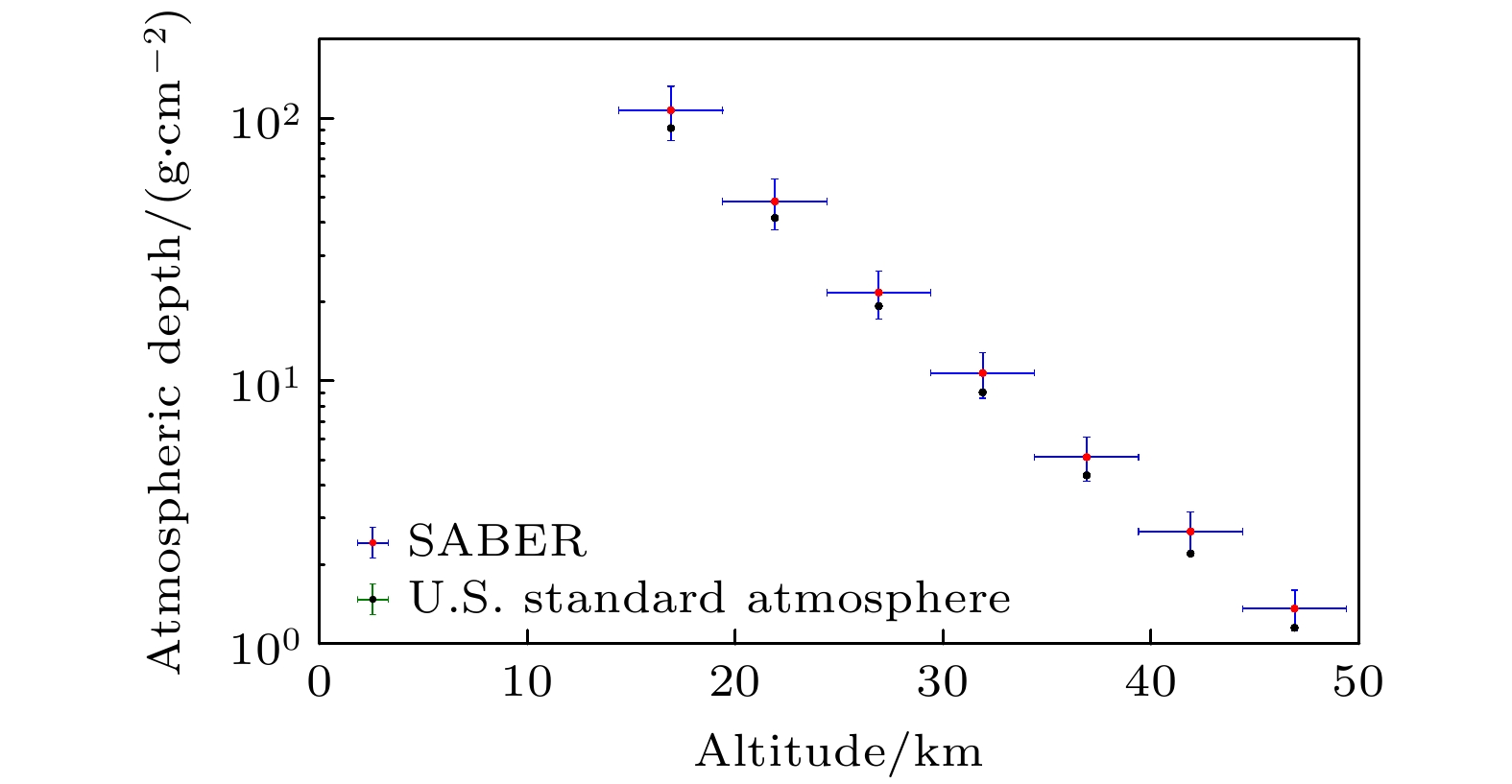
 下载:
下载:
